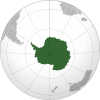geo.wikisort.org - Mountains
Borg Massif is a mountain massif, about 50 km (30 mi) long and with summits above 2,700 metres (8,900 ft), situated along the northwest side of the Penck Trough in Queen Maud Land, East Antarctica.[2] The tallest peak, at 2,727 metres (8,947 ft), is Hogsaetet Mountain. The parallel, ice-filled Raudberg Valley and Frostlendet Valley trend northeastward through the massif, dividing its summits into three rough groups:
| Borg Massif | |
|---|---|
| Borgmassivet | |
 Borg Massif Location within Queen Maud Land, East Antarctica | |
| Highest point | |
| Peak | Høgsaetet Mountain |
| Elevation | 2,717 m (8,914 ft) [1] |
| Coordinates | 72°45′S 3°30′E |
| Geography | |
| Continent | Antarctica |
| Sector | Queen Maud Land |
| Climbing | |
| Easiest route | snow/ice climb |
Discovery and naming
The feature was photographed from the air by the Third German Antarctic Expedition (1938–1939), led by Captain Alfred Ritscher, but was not correctly shown on the maps by the expedition. It was mapped in detail by Norwegian cartographers from surveys and air photos by the Norwegian–British–Swedish Antarctic Expedition (1949–1952), led by John Schjelderup Giæver. It was remapped by air photos taken by the Sixth Norwegian Antarctic Expedition (1958–1959). They named it "Borgmassivet" (the castle massif) in association with Borg Mountain, its most prominent feature.[2]
Features
- Located at the northern end of the Borg Massif is the summit of Borg Mountain, a large, flattish, ice-topped mountain with many exposed rock cliffs. Dugurdspiggen Peak lies 4 nautical miles (7.4 km; 4.6 mi) north of the massif.
- Located at the northeastern end of the Borg Massif is the summit of Ytstenut Peak. The name "Ytstenut" means "outermost peak" in the Norwegian language.
- Located at the southern end of the Borg Massif is the summit of Hogfonna Mountain. The name "Hogfonna" means "the high snowfield" in the Norwegian language.
See also
References
- Map "Ritscherhochland" Archived 3 July 2011 at the Wayback Machine
- U.S. Geological Survey Geographic Names Information System: Borg Massif
External links
- Scientific Committee on Antarctic Research (SCAR)
- Composite Gazetteer of Antarctica
 This article incorporates public domain material from the United States Geological Survey document: "Borg Massif". (content from the Geographic Names Information System)
This article incorporates public domain material from the United States Geological Survey document: "Borg Massif". (content from the Geographic Names Information System)
На других языках
[de] Borg-Massiv
Das Borg-Massiv (norwegisch Borgmassivet) ist ein imposantes Gebirgsmassiv von rund 50 km Länge im antarktischen Königin-Maud-Land mit Gipfeln von bis zu 2770 m Höhe. Es ragt entlang der Penck-Mulde im östlichen Teil der Maudheimvidda auf und ist mit nordöstlicher Ausrichtung in drei schroffe Bergkämme untergliedert, die durch das Raudbergtal und des Tals Frostlendet voneinander getrennt werden. Markanteste Erhebung des Massivs ist die 2594 m hohe Borga.- [en] Borg Massif
Другой контент может иметь иную лицензию. Перед использованием материалов сайта WikiSort.org внимательно изучите правила лицензирования конкретных элементов наполнения сайта.
WikiSort.org - проект по пересортировке и дополнению контента Википедии
